Brogue detailing exists on some of the most iconic and popular footwear options, from styles of boots to Oxford shoes, loafers, and Derby shoes. But what exactly is broguing? What’s the history behind brogue shoes? And how can they fit into your wardrobe? Read on to find out.
Brogue Shoes & Boots: The Definitive Video Guide
What Does “Brogues” Mean? The Brogue Shoe Defined
Though the term ‘brogue’ also refers to an Irish accent and other regional accents from the United Kingdom, a brogue for the fashionable man is a dress shoe that features the decorative element known as broguing.
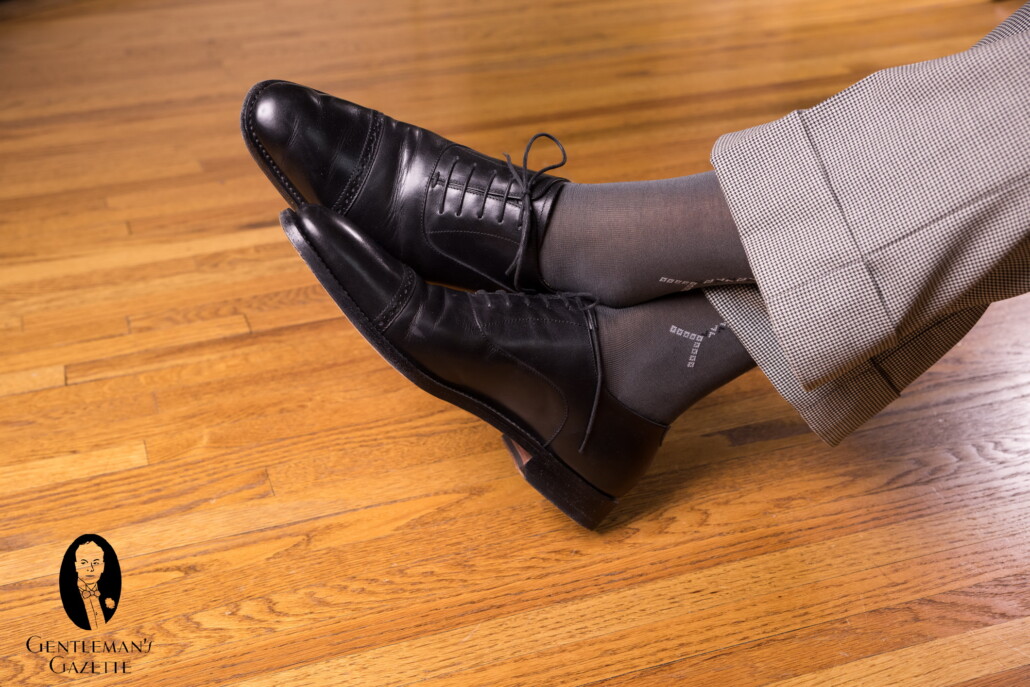
The Merriam–Webster dictionary describes broguing (brogue: ing – noun) as an ornamentation of shoes employing heavy perforations and pinking. Therefore, it stands to reason that any shoe with perforations, whether it be an Oxford, Derby, wholecut, or a Budapester, could be considered a pair of brogues.
Common Brogue Misconceptions
There is often confusion with the terms “Oxford”, “Derby”, and “Brogue”. An Oxford shoe is characterized by its lacing system, or to be specific, by the shoelace eyelets that are attached under the vamp. This is called ‘closed lacing.’ On the other hand, a Derby shoe has ‘open lacing’ where the eyelets are attached to the top of the vamp.
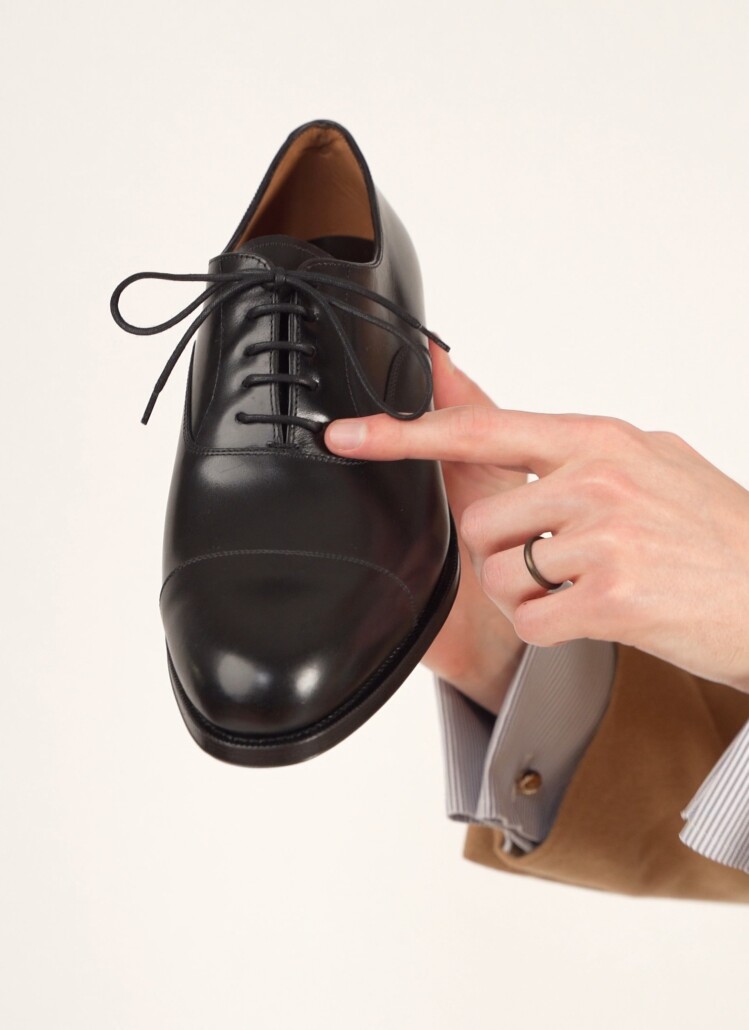
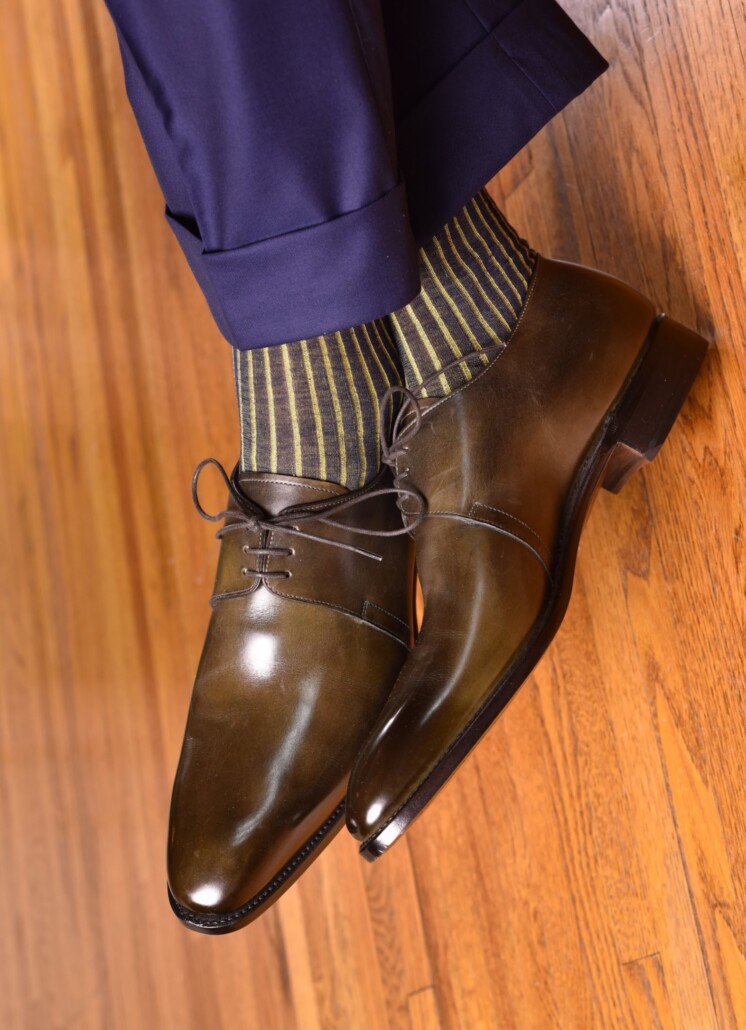
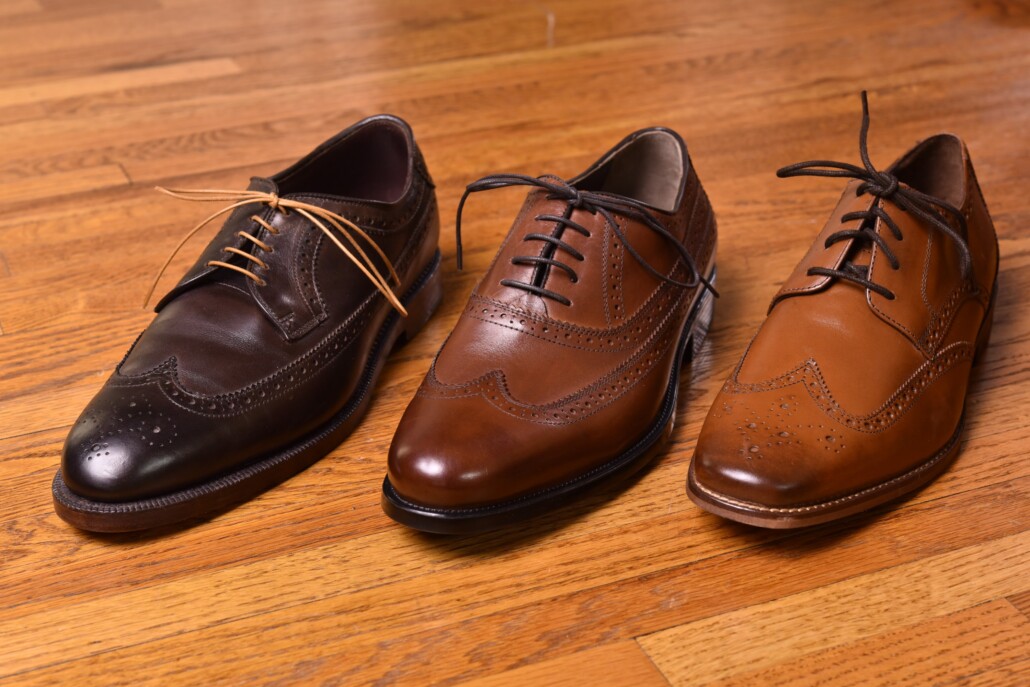
It’s important to remember that Oxfords are not always brogues, and brogues are not always Oxfords. The closure method for the type of shoes or boots will have one name, such as an Oxford or Derby, and the broguing refers to the decoration present on the uppers. When someone refers to their footwear as a pair of “Brogues” you can assume there is some form of perforation or detailing on them, but you can’t assume the closure style.
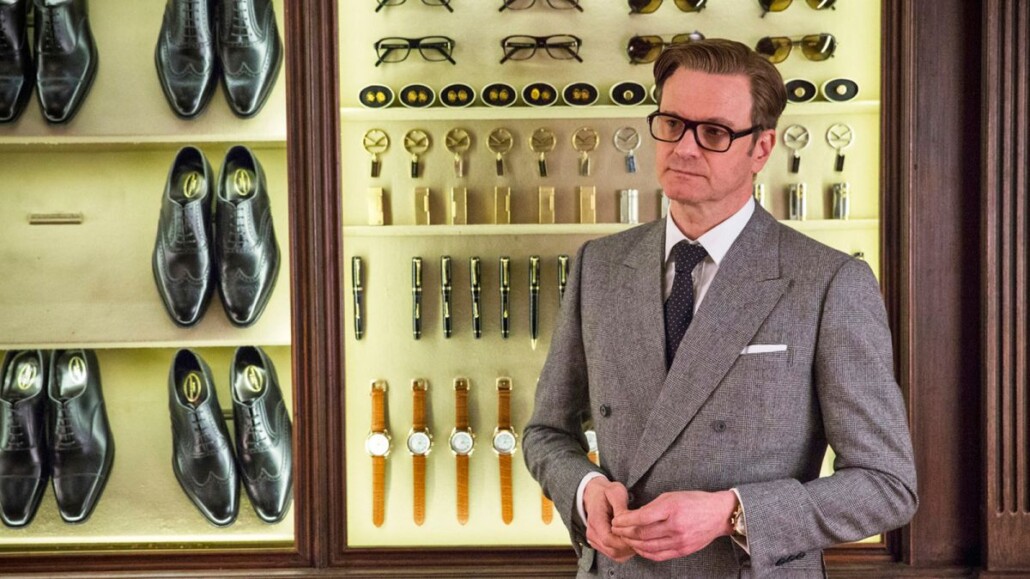
“Oxfords, not brogues.”
Harry hart – Kingsman: The Secret Service
While initially, Oxfords were plain formal shoes, they subsequently evolved into a range of styles both formal and casual. Some of these styles feature broguing or perforations along the edges of the individual leather pieces and thus can be called brogues.
Sit back and relax as Raphael guides you through the world of men’s brogues. Find out if they’re the most versatile shoes or not, explore a variety of styles, and learn how to incorporate this staple shoe into your classic gentleman’s wardrobe.
The Origins and History of Brogue Shoes
The brogue was originally designed in Scotland and Ireland as a shoe suitable for wearing while working outdoors. The Irish and Scottish countryside is wet and characterized by bogs that made life very difficult for the people who worked there and, as you might expect, their feet took a beating.
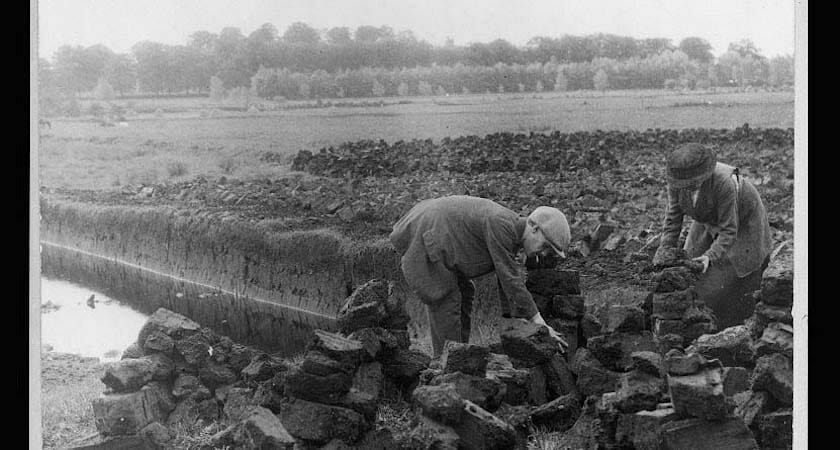
They needed shoes that were suitable for rough outdoor work and terrain. The Irish word “brog” means a rough or stout shoe. Interestingly this term supposedly originated from the (rather harsh) perception that the Irish spoke as if they had a shoe in their mouths!
The original brogues were rudimentary shoes made with untanned animal hide; their distinctive feature was a series of perforations and serrations (broguing) of each piece of leather that was used in their construction. The purpose of these perforations was to allow water to drain from the shoes.
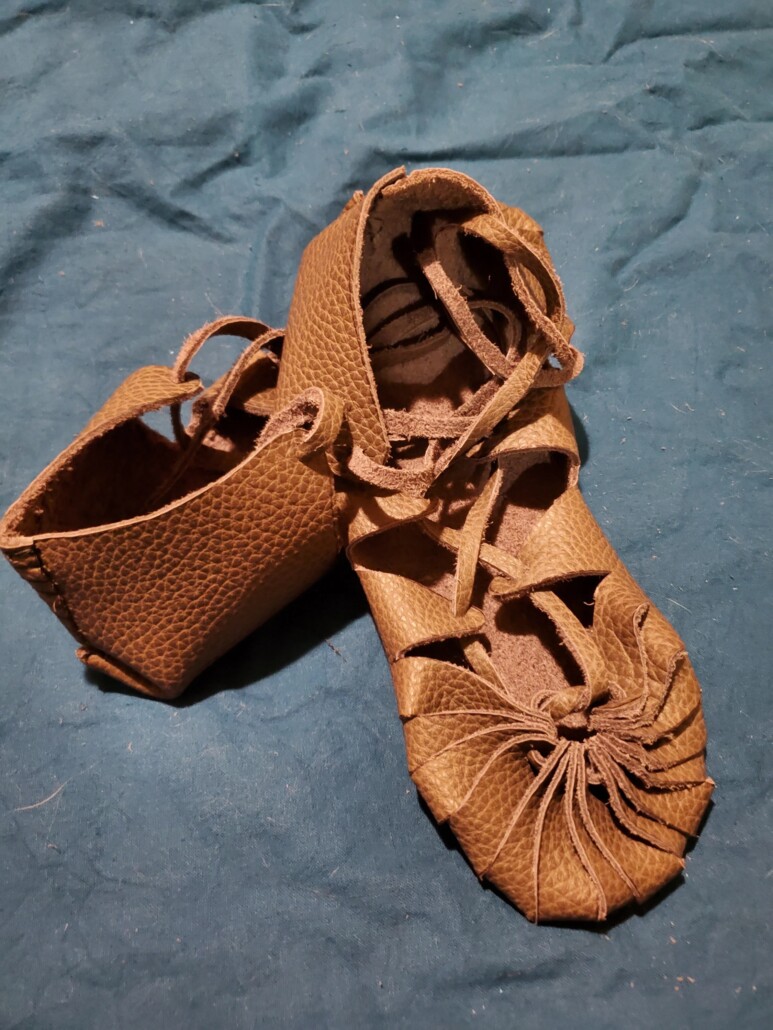
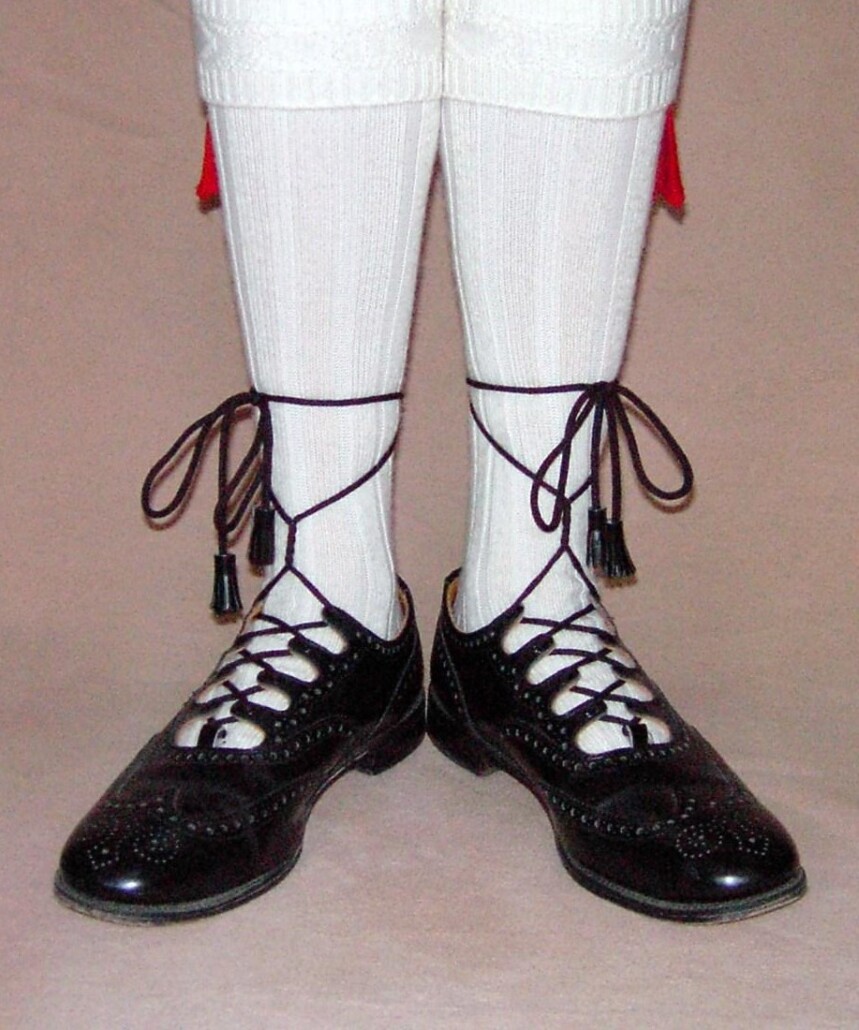
Another feature of their design was that they were laced with leather tangs and did not have the tongue as in other shoes; they also had high lacing that wrapped above the ankles. This design feature kept the lace knot free from muck and dirt and prevented the shoes from being caught while walking in the mud. This basic design is now known as the ‘ghillie brogue’ and is often considered the standard style for traditional Scottish dress footwear. It’s not often that a shoe can go from bog to ballroom!
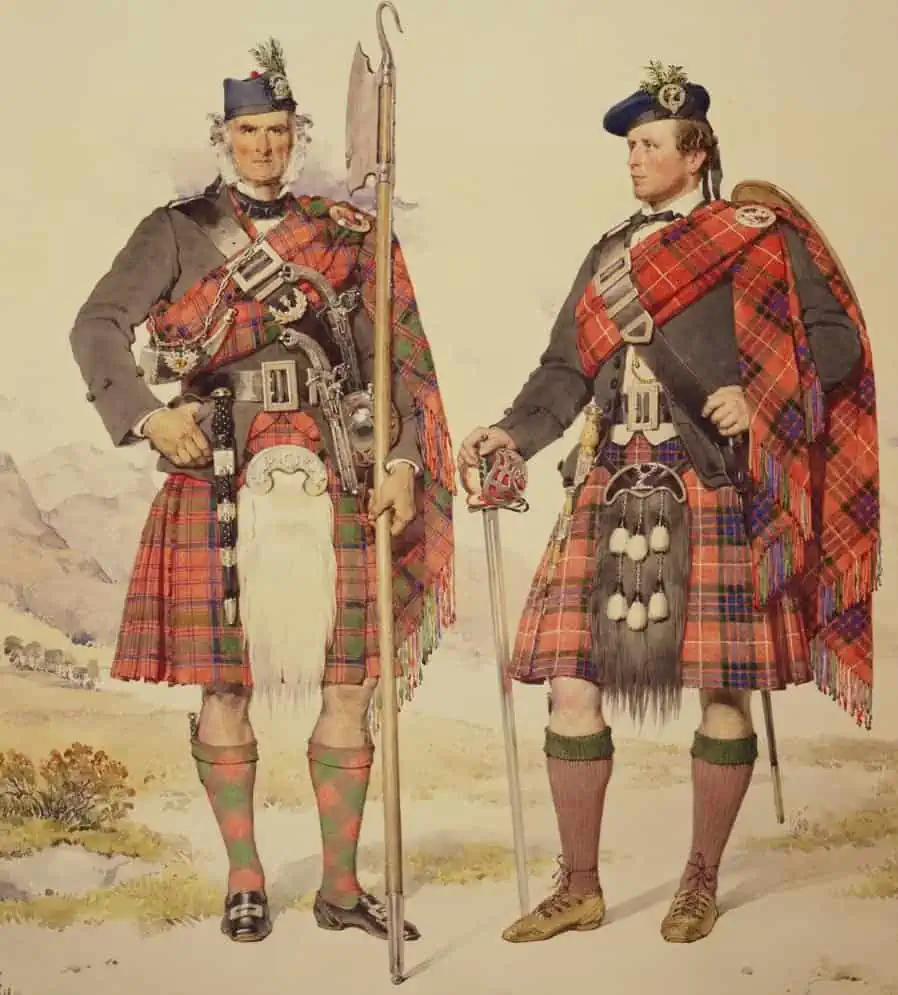
Over time they were adopted by country gentlemen as outdoor country walking shoes. It is because of these very roots that they were not considered appropriate wear for other social or business occasions during that time. However, things changed in the twentieth century when the brogue was used as a template for fashionable women’s footwear.
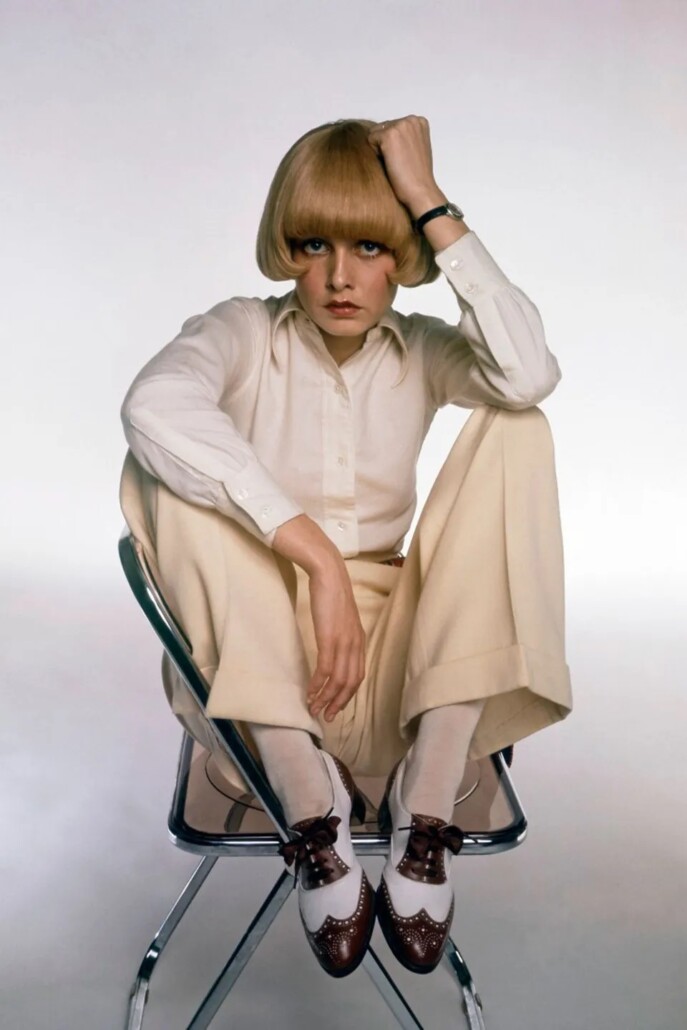
At this point, the brogue details were now used solely for decorative purposes. Famous celebrity women such as the actresses Marlene Dietrich and Katherine Hepburn incorporated it into their signature style of daring masculine fashion choices. The model Twiggy also favored the shoe, reportedly made by George Cleverley after she challenged him to design her pair of flat shoes. All this led to a rise in its popularity. Due to this influence, perceptions began to change and slowly the brogue began to be considered appropriate wear, even for men for most occasions both social and business.
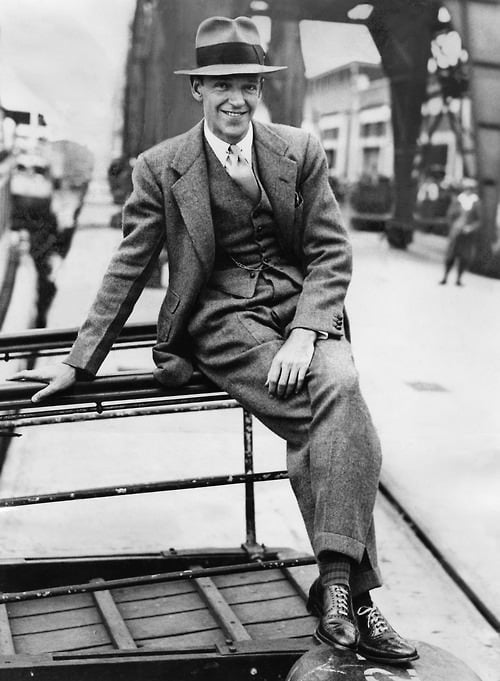
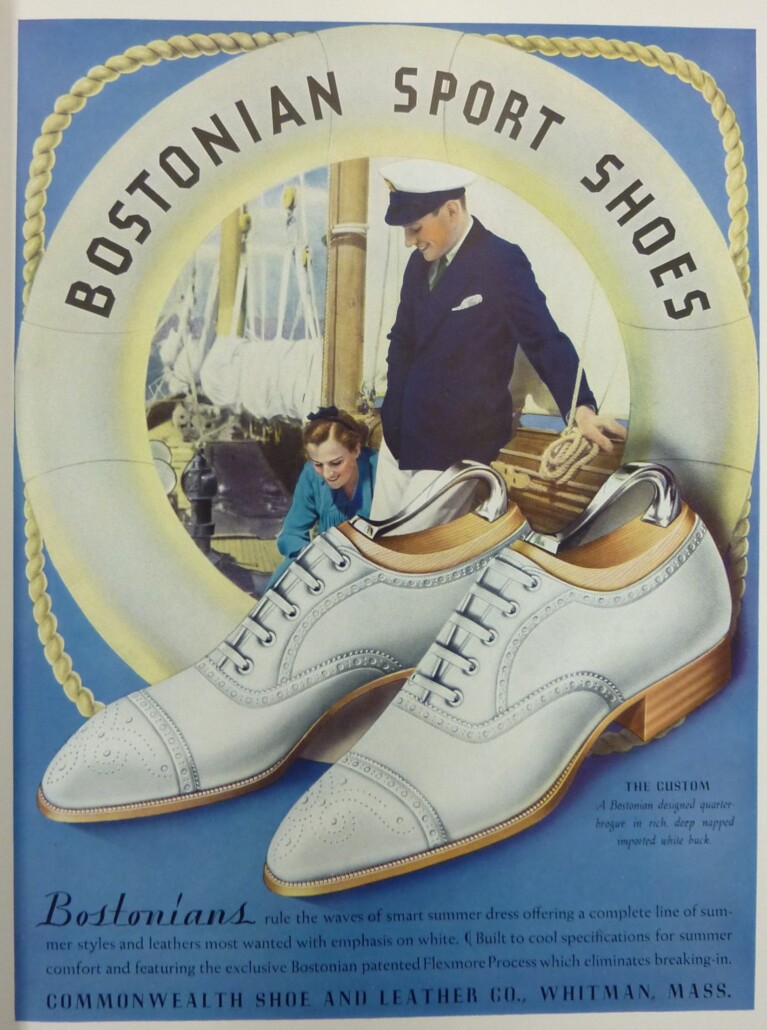
By the 1920s, men’s brogues were extremely popular, especially in the United States but also in England and continental Europe. The brogue was now an integral part of people’s wardrobes. Stars like Fred Astaire, Gary Cooper, and Cary Grant all wore brogue shoes often, and you can regularly see men of the Golden Age of Style frequently pictured in a pair of brogues.
What Else Did Men REALLY Wear in the 1920s?
Since then, brogues have become increasingly common in everyday life. As stricter fashion rules have been relaxed, brogues have taken on quite a smart look, being featured in many formal outfits as well as the more traditional casual look that brogues are known for.
Brogue Characteristics: What Makes it a Brogue?
Without a doubt, brogues come in a wide variety of styles. Regardless of the exact details that feature, there are some basic characteristics you are likely to find in most brogues.
Brogue Characteristics
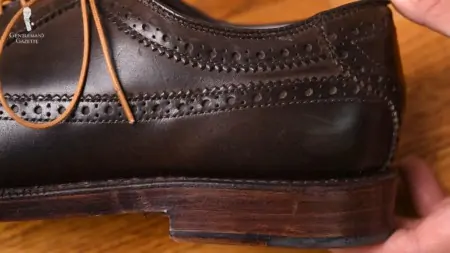
Perforations
One of the most typical characteristics of a pair of brogues is the decorative perforations, or holes, that form part of the design. Where these used to serve a practical purpose of moisture drainage, they are now purely decorative.
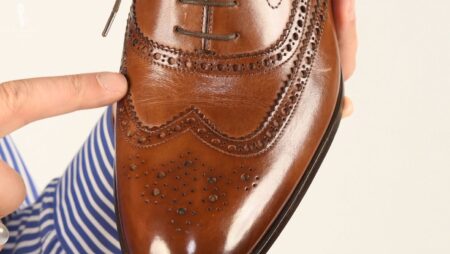
Toe Caps
Whether it’s a classic straight toe cap or an elongated wingtip, many brogues feature a cap of some variety. This is to ensure this additional piece receives the decorative perforations before being stitched to the rest of the shoe.
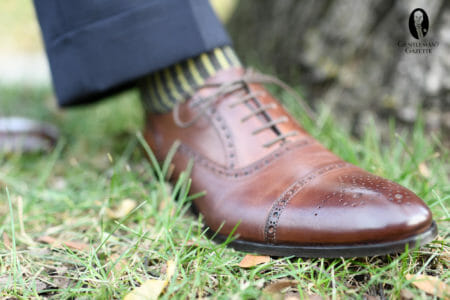
Medallion
A medallion is usually displayed on the front of the toe, made of smaller perforations than the broguing that features on the edges. There are many medallion designs out there, and you can even request a custom medallion if you’re getting a pair of bespoke brogues.
It’s also worth noting that these characteristics remain the same regardless of the construction or style of footwear. It doesn’t matter whether the shoe’s sole has Goodyear-welting or Blake stitching, and it can be a shoe, boot, or loafer – if the characteristics listed above are present, then it’s a brogue as well.
Brogue Shoes FAQs
What makes a shoe a brogue?
The brogue part of a shoe traditionally comes from additional decorative perforations present on the shoe’s upper. This can be in the form of a simple medallion or a full brogue with a wing tip and perforations bordering the sides.
What’s the difference between an Oxford and a brogue?
Thanks to the Kingsman film series, many people may be confused by thinking that Oxfords and brogues are different types of shoes, however, an Oxford can also be a pair of brogues, and vice versa. The “Oxford” refers to the closed lacing system, and the “Brogue” refers to the decorative perforations.
Can men wear brogues?
Men can absolutely wear brogues! They are a staple of a well-dressed gentleman’s wardrobe, and there are many variations of the brogue that will suit a range of tastes.
Are brogues still fashionable?
Historically, brogues have always been stylish. Whatever is in fashion will always change, but an elegant pair of brogues will always be in style.
When should you not wear brogues?
As they are more casual, brogues should be avoided when very high degrees of formality are required. Therefore, brogues are best left in the closet when attending boardroom meetings, black-tie, and white-tie events.
Can you wear jeans with brogues?
Denim jeans can be worn with brogues, but it’s best to get both your denim and brogues right first. Your jeans should be in a classic cut, not too slim, and without additional details or weathering. You can then pair them with some mid-brown brogues for a particularly classic relaxed look.
Can you wear brogues with a dinner suit?
Simply put, no – you can’t wear brogues with a dinner suit. The style is far too casual for the level of formality required for eveningwear.
What is the purpose of broguing?
Originally, the broguing perforations served the purpose of draining the shoes worn by bog workers. As the ground is heavily saturated, their footwear needed to have the ability to release moisture quickly. As the style developed, the broguing became purely decorative.
A Selection of Classic Brogue Styles
Various designs and styles of brogues have evolved over time. We’ve included a selection of the most popular, as well as a few unusual styles that may not be as common but are no less elegant.
Full Brogues or Wingtips
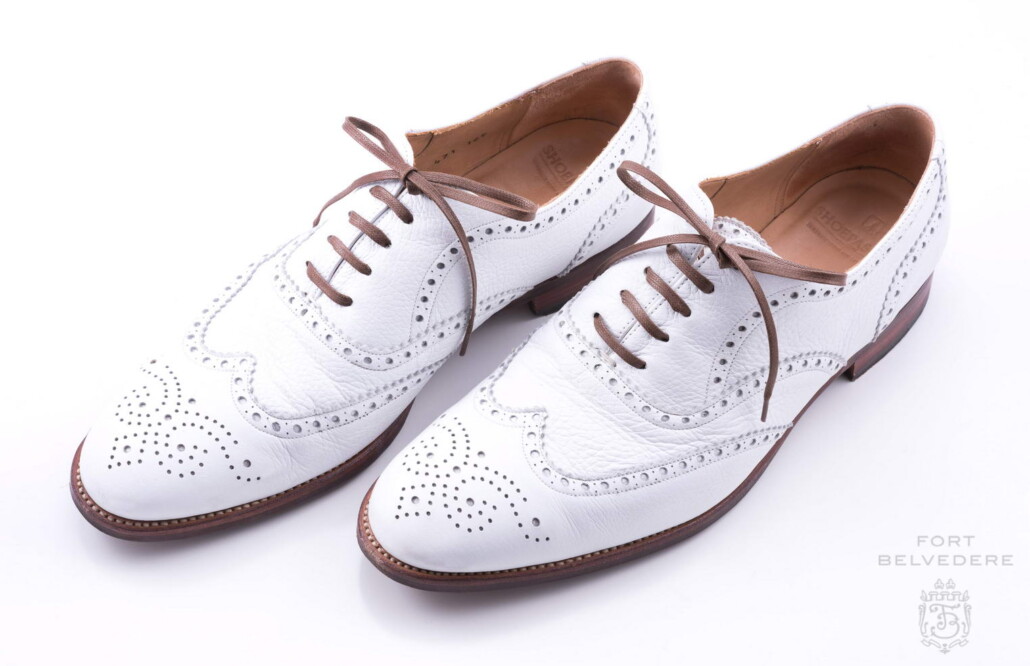
“Full brogue shoes” or “wingtips” are terms that can be used interchangeably to describe a pair of brogues that have a pointed cap toe that extends along both sides of the shoe and usually ends near the ball of the foot. When seen from above the cap is shaped like a ‘W’ or ‘M’ depending on the viewpoint. It features broguing along its edges and typically decorative broguing in the center of the toe which is called a medallion.
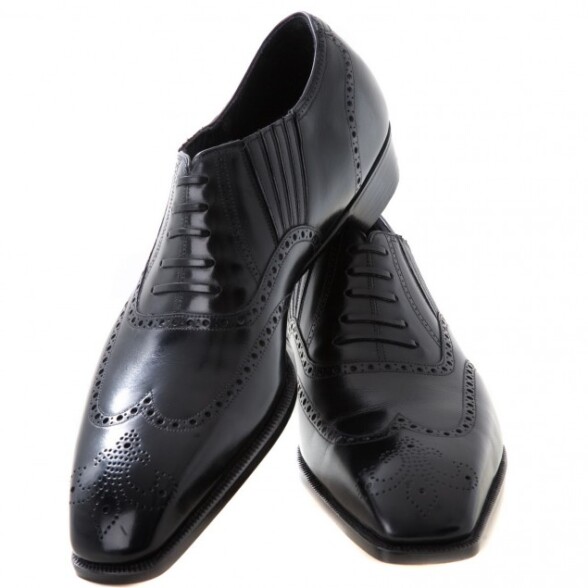
An Elegant Alternative
The wing tip on a pair of brogues is usually an additional piece of material added on top of the shoe’s existing toe. However, there is a style of brogues that are known as “Imitation Brogues”. Constructed like a wholecut shoe, this style still features stitching and perforations, but on one layer of leather instead of multiple pieces. The style is very streamlined and elegant, and makes a great choice if you struggle with discomfort from multiple layers of leather on your feet.
Spectator Shoes
Spectator shoes are a variation of brogues that are made in two contrasting colors. Usually, the toe and heel caps and sometimes the lace panels are in a darker color than the main body of the shoe.
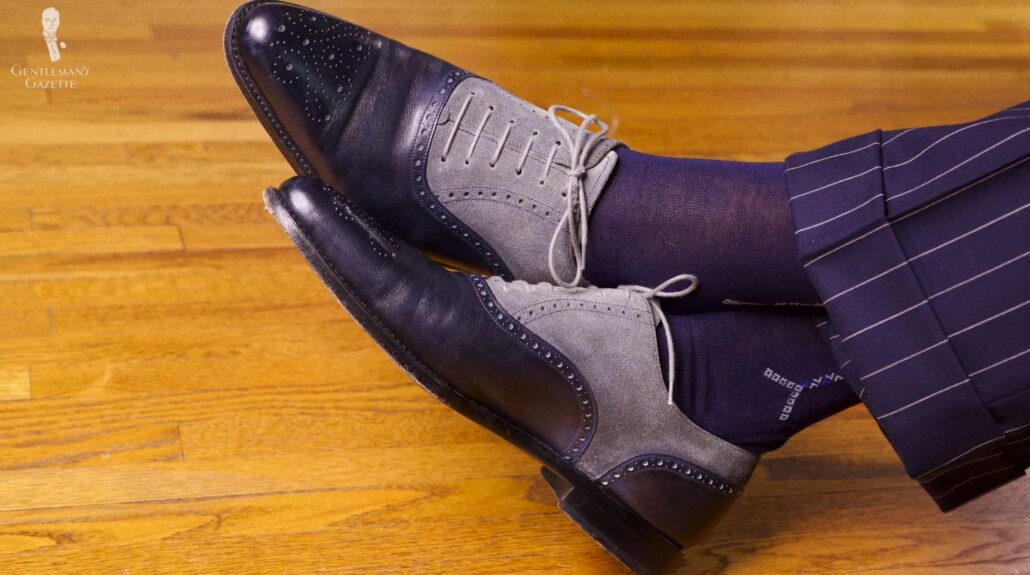
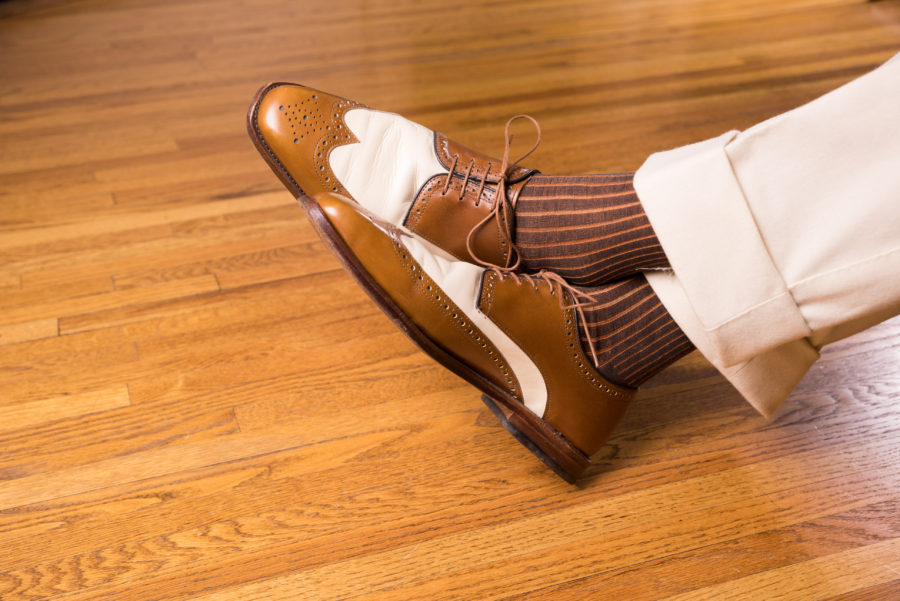
Typically the main body of the shoe is made of white or off-white leather or canvas fabric, but lately, all kinds of materials, colors, and textures have been utilized including tweed.
Blind Brogues
A pair of blind brogues specifically relates to the wingtip toe cap variety, however, there is only broguing along the edges and no medallion on the toe.
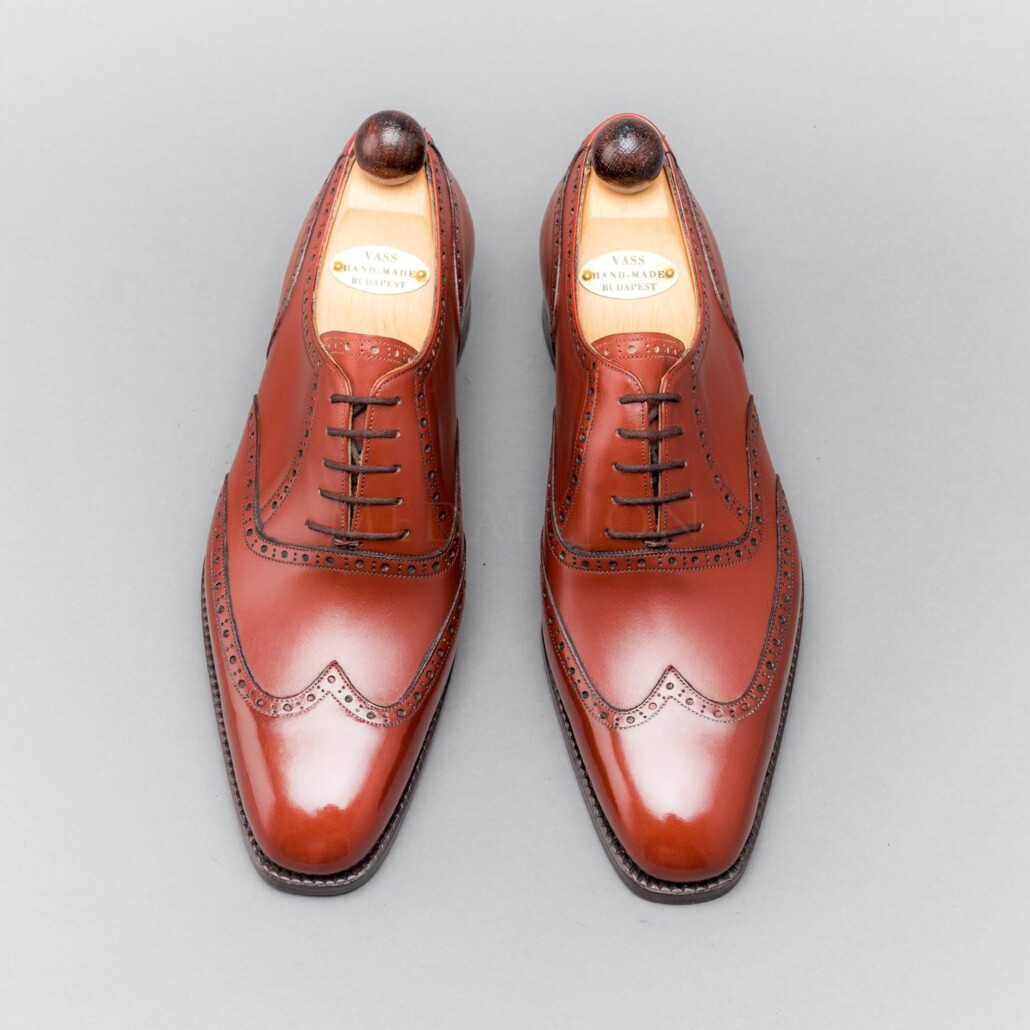
Longwing Brogues
Longwing brogues differ from full brogues or wingtips in that the ‘wings’ of the wingtip wrap around the full length of the shoe and meet at a center seam at the heel. Interestingly, they may be referred to as ‘English brogues’ in the US and as ‘American brogues’ in the UK.
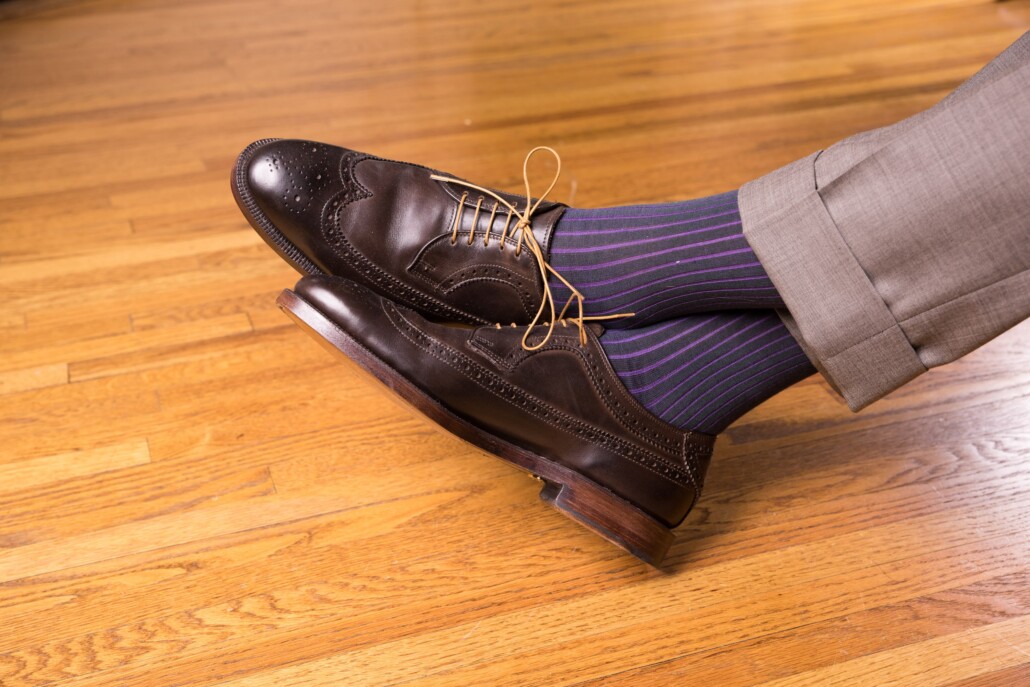
As this style has the effect of elongating your foot, most longwing brogues are made in the Derby style to create balance. Of course, Oxford longwing brogues do exist, too.
Austerity Brogue
A slightly confusing term, as these “brogues” actually feature no broguing at all! A wingtip toe cap without any broguing (either along the edge of the toe cap or in its center) can be called an austerity brogue (due to the somewhat ironic lack of broguing).
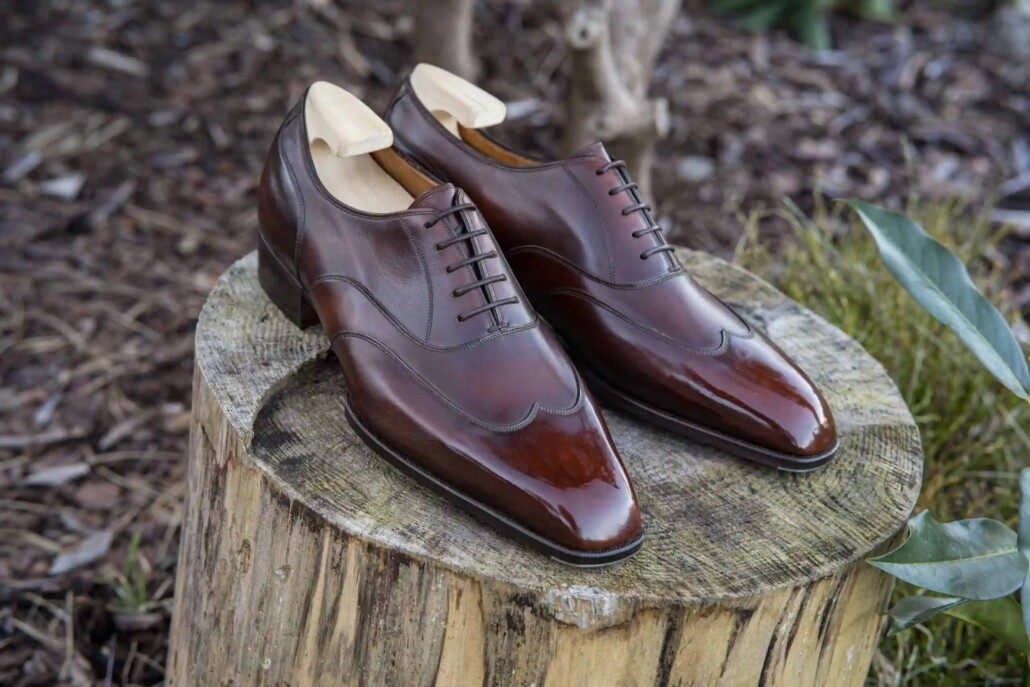
This can be a puzzling style of brogues to a newcomer, as technically speaking it goes against all of the criteria to be called a brogue! However, many shoemakers offer this style under the universal name of an austerity brogue, as the wingtip toe cap is so closely related to brogues in general.
Semi or Half Brogues
Semi or half brogues have a straight toe cap without extensions or wings and feature broguing both along the cap’s edge and sides. You’ll also see a medallion on the toe cap. This style was first designed by the famous London shoemakers John Lobb Ltd in 1937.
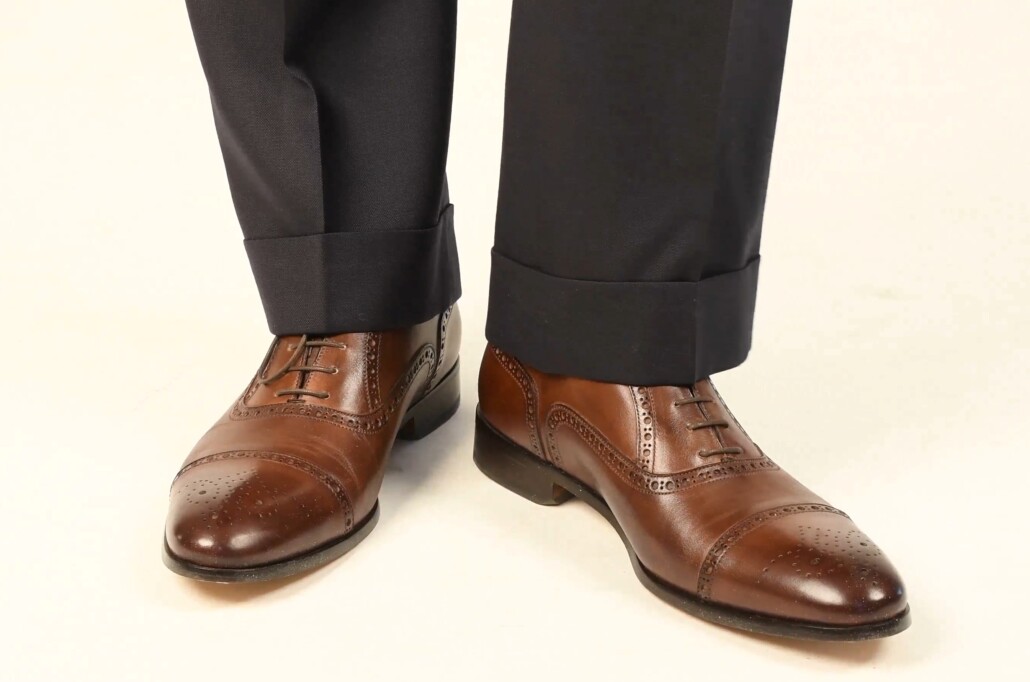
Today, you will find many variations of the semi-brogue, including an inverted V cap and a second, recessed piece of brogued leather between the cap and the laces.
Quarter Brogues
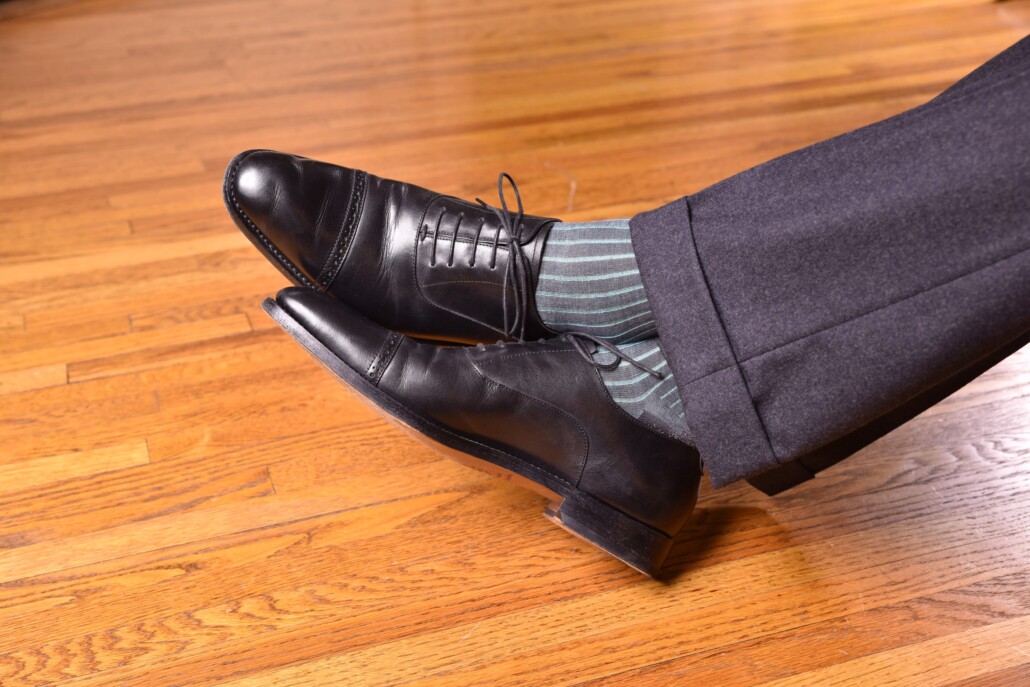
Quarter brogues, like semi or half-brogues, have toe caps without points and extensions or wings. However, they differ from the semi or half brogues in that they have broguing only along the edge of the cap and they do not have a medallion.
Ghillie Brogues
Ghillie brogues are the standard style for traditional formal Scottish dress footwear, including a black version for evening wear.
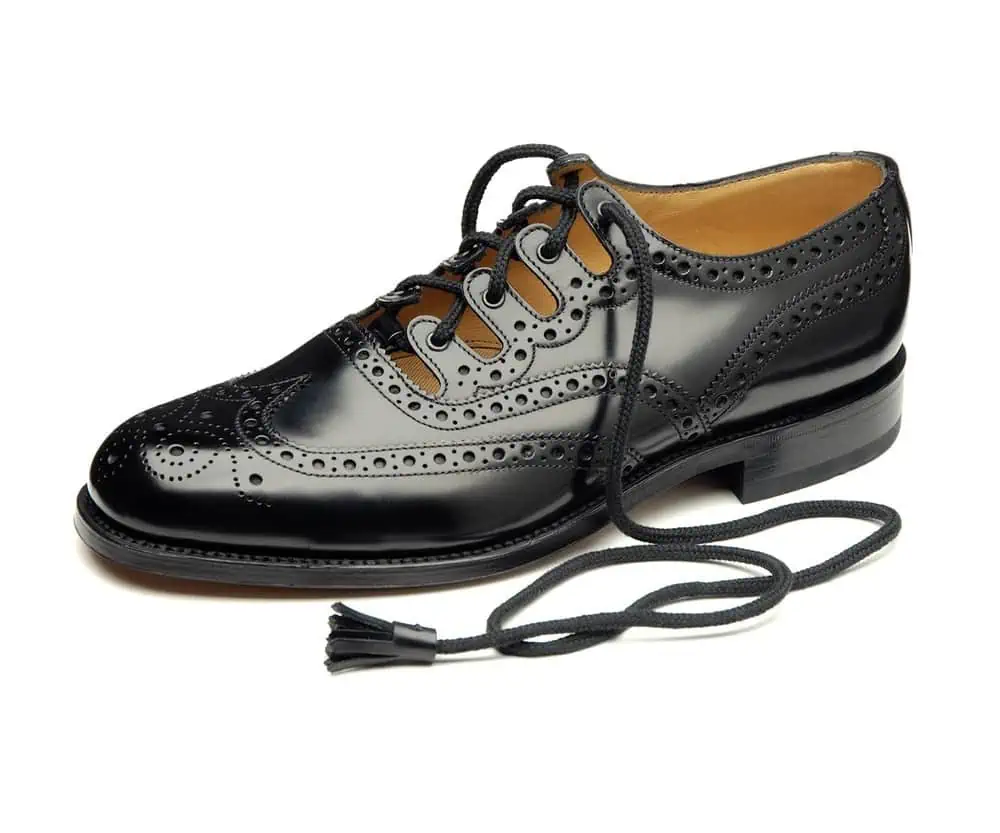
They are a full brogue or wingtip but differ in that they do not have a tongue and feature long laces that wrap around the legs above the ankle and are tied below the calf. Versions of the ghillie brogue are also available without ankle laces.
U-Cap or U-Tip Brogue
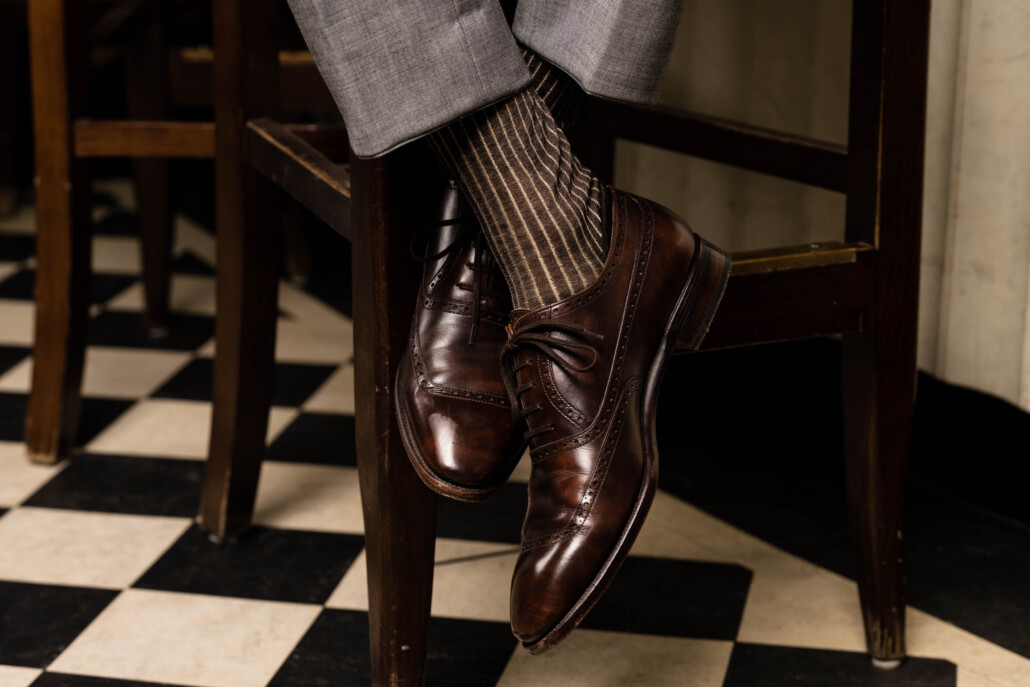
A U-Cap or U-Tip brogue is a popular adaptation of a full brogue in which the cap is U-shaped rather than pointed like a wingtip and wraps around the vamp of the shoe.
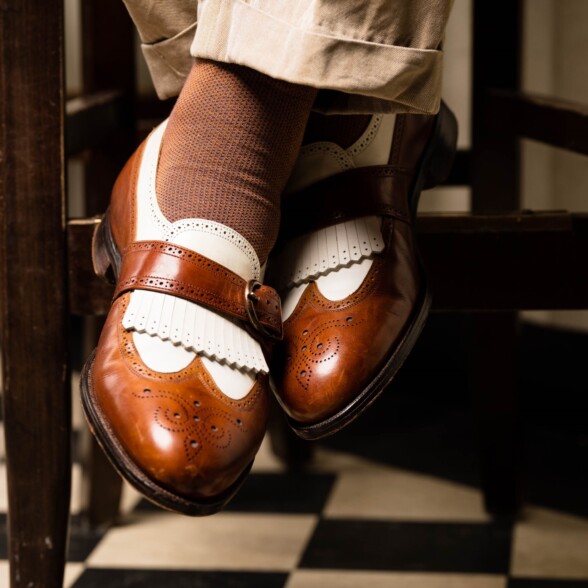
Closing Time
Brogues can feature almost any dress shoe closure style or lacing systems, however, these are not defining characteristics of a brogue except in the case of the Ghillie brogue. Some common closure styles available are laced Oxfords, Derbys, buckled monk straps (double and single), side gussets, loafers, and boots (with or without laces).
How to Wear Brogues: Wear Your Brogues with Style
Brogues are incredibly versatile, and most men interested in classic style will have many variations in their closets for a range of outfits. Today, the right style of full brogue could be considered a great shoe to wear with a three-piece pin-stripe suit, and a quarter brogue in black or oxblood is a perfect business shoe.
Brogues and Business Wear: Formal Suits and Business Attire
When worn as a dress shoe with a suit, it is better to opt for either half brogues or quarter brogues as they are not too elaborate and maintain the formality of the outfit. A full brogue is mostly too casual for a worsted suit but will work with tweed or other country fabrics.
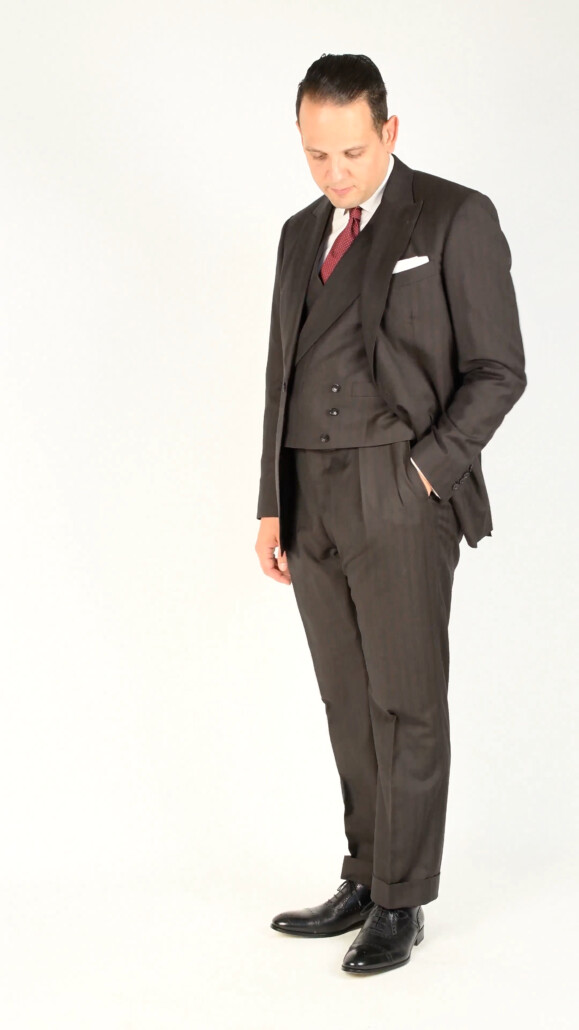
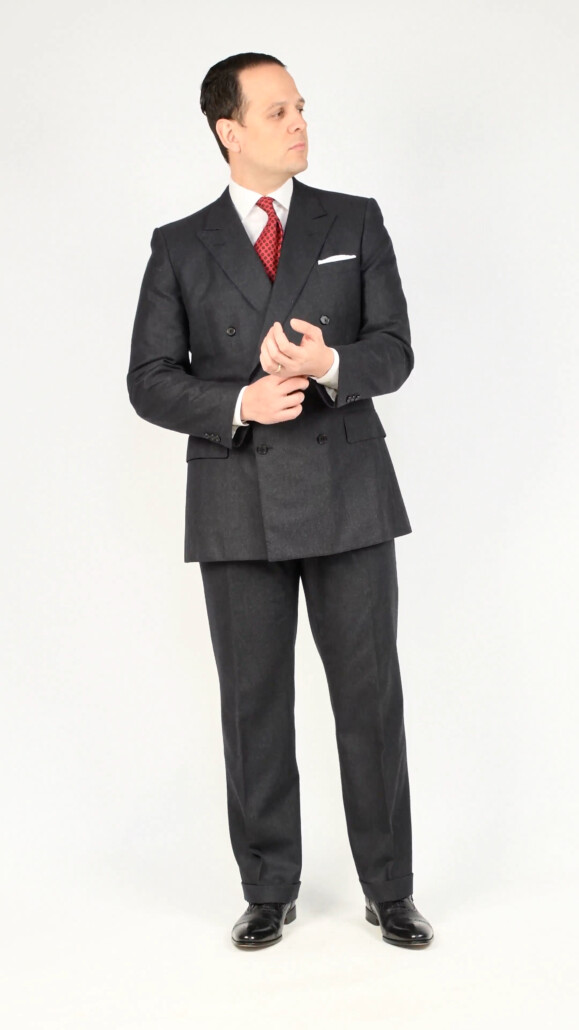
That being said, you should be able to make a full brogue work if you pay attention to the details; ensure the sole is slim and neat to the foot for starters, and smooth, well-polished leather will help too. The imitation brogue is a particularly elegant style of full brogue that is your best bet when thinking about the boardroom.
Brogues and Business Casual: Everyday Office Attire
For most semi–formal occasions where a full suit is not required and a blazer or a sports coat will suffice, the wingtip or muted spectator makes for an ideal choice. It maintains just the right amount of formality and casualness, making it perfect for business casual environments.
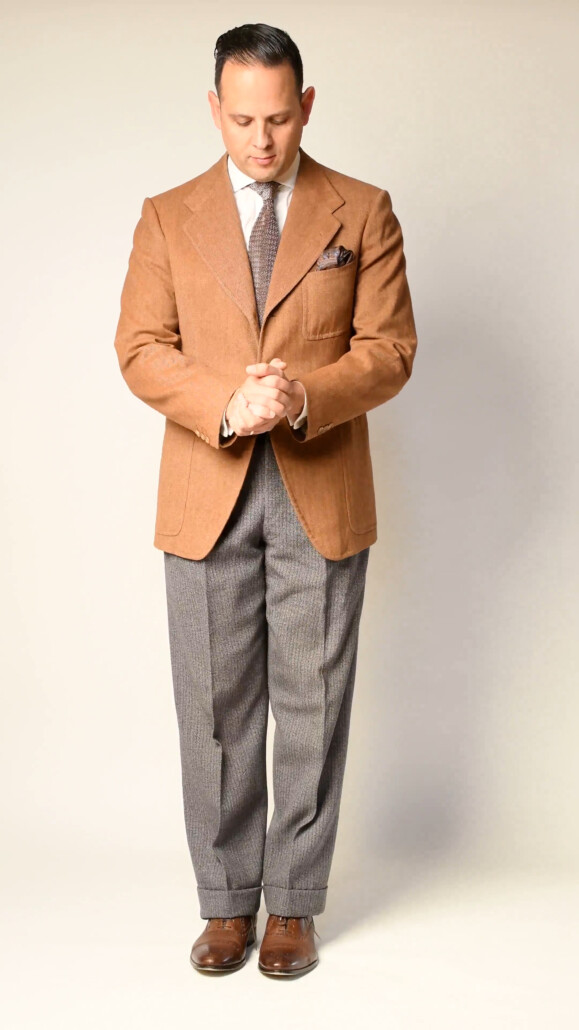
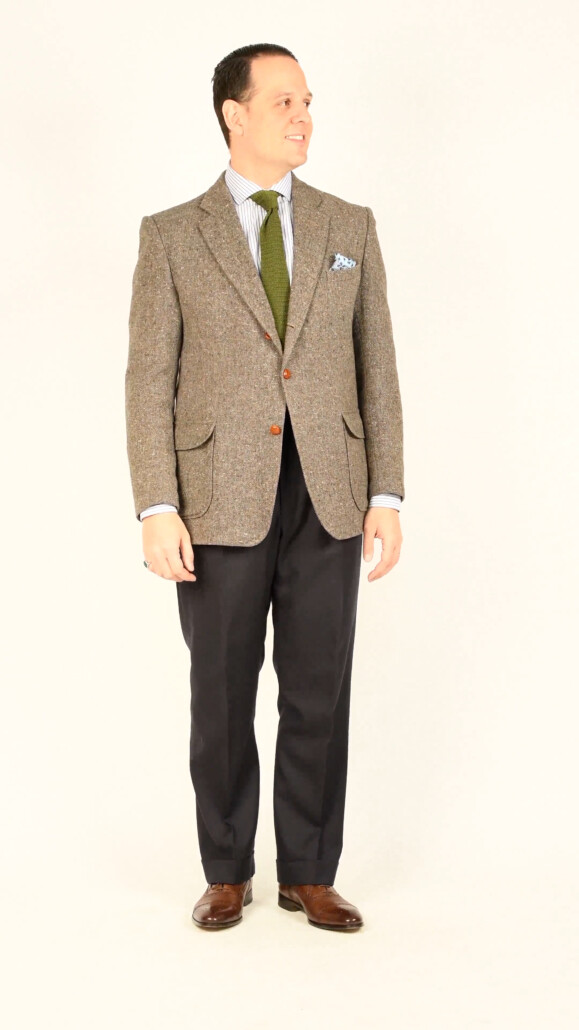
Every man should have at least one pair of brogue shoes and once you increase the number of shoes in your collection, probably half of your shoes or more will have some sort of broguing. If versatility is your goal, the oxblood semi-brogue is probably the way to go but a chestnut brown will also work with many outfits. Of course, if you work at a bank, law firm, or a similar white-collar job, go with black quarter brogues.
Brogues for the Weekend: Wearing Brogues Casually
In a casual setting, the brogue can be paired with jeans, chinos, and most other casual trousers. Brogues also work especially well with Blazers, Hacking Jackets, turtlenecks, sports coats, casual suits in lighter colors and tweed, or even a Harrington jacket.
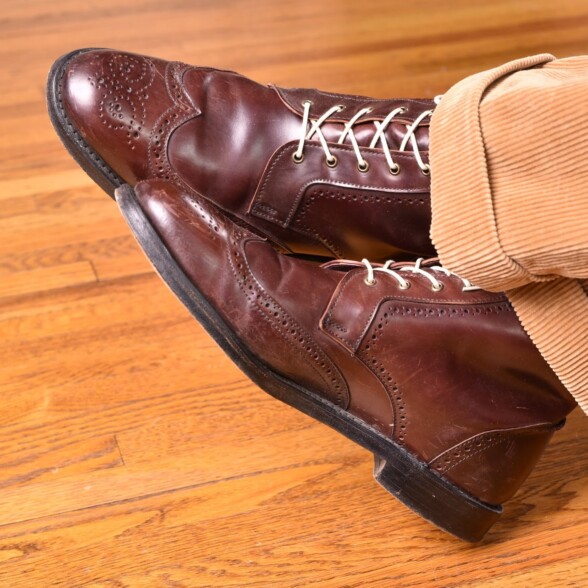
Play With Different Styles
Wearing brogues casually offers the best opportunity to experiment with different styles. Suede full or half brogues in various shades of brown are absolutely timeless. Tan is a wonderful color for country boots, and you can also experiment with boots in oxblood cordovan.
As a rule of thumb, always bear in mind that a shoe is less formal the more broguing it has and vice versa. As such, full brogues are perfect when combined with anything related to country attire, and semi-brogues in a darker brown color are very versatile and can be worn with tweed as well as casual worsted sports coats and brown suits.
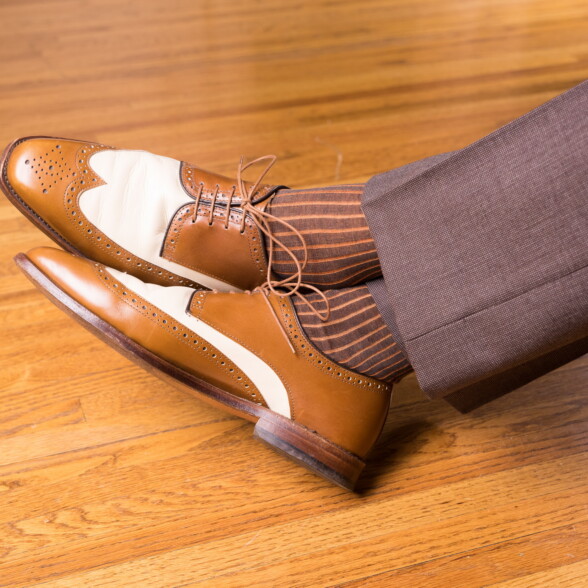
Simply Spectating
Spectator shoes are not everybody’s cup of tea and can be difficult to pull off. If you have confidence in your style you can wear them anywhere you want – except for formal occasions of course. The basic rules for matching shoe colors with the rest of your outfit apply here as well.
While some men wear brogues with shorts, this look can seem a bit imbalanced. Go for a more appropriate shoe if you’re wearing shorts, like a pair of loafers, espadrilles, or boat shoes.
Brogues and Black Tie? Avoid Brogues with Evening Wear
While it’s entirely possible to see all manner of styles on the red carpet, brogues are never appropriate for black tie or white tie events, unless you wear black ghillie brogues as part of Scottish Highland dress.
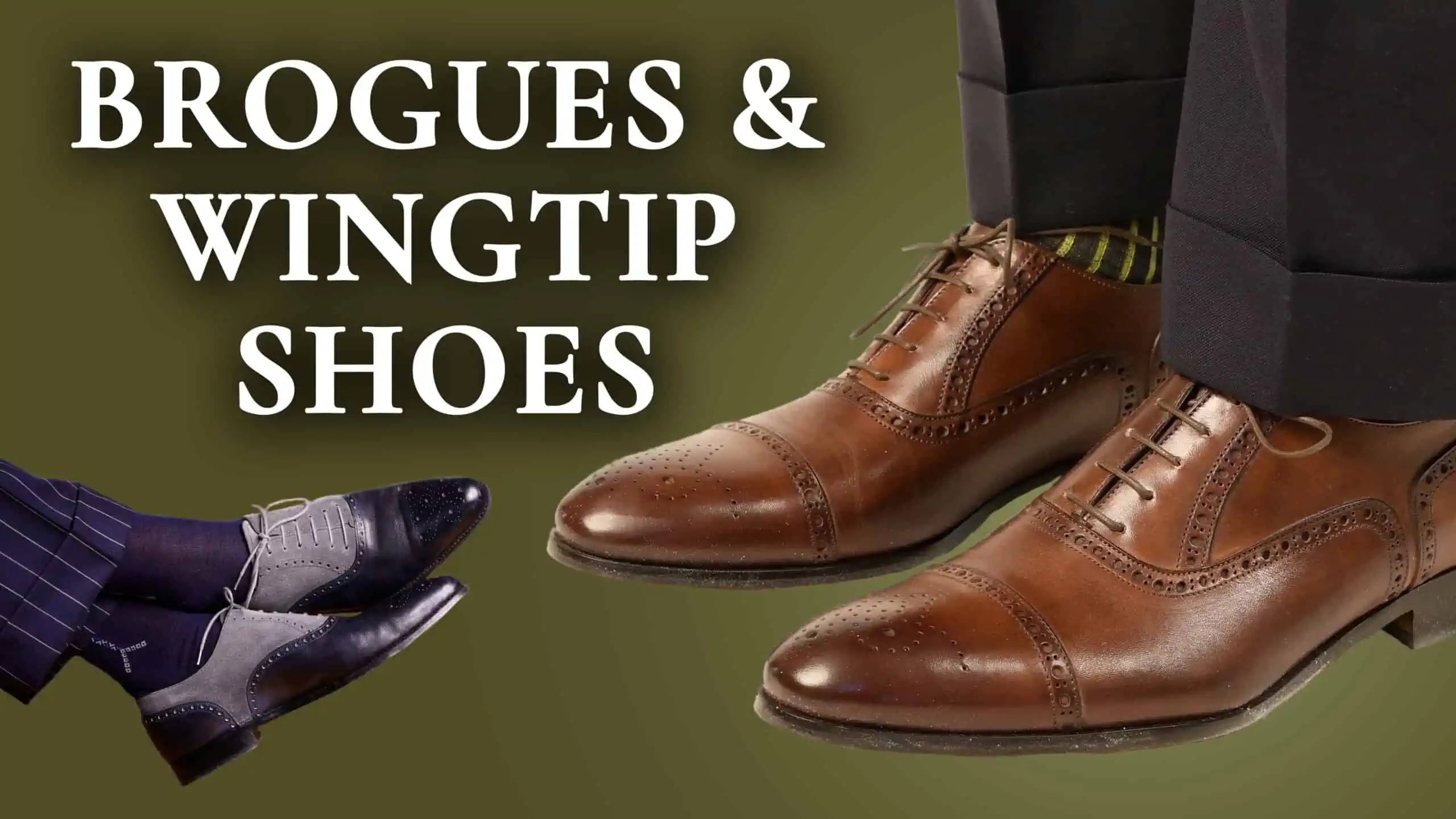
Derby is not a Brogue I thought.
Enjoyed the article. You mention the Irish working origin of the Brogue but were you aware that Brog is actually the Irish for shoe.
Anthony, the article states:”The Irish word brog means ‘a rough or stout shoe” ;)
As an Irishman, the Irish word “bróg” is indeed used for all shoes.
So it does Sven, my apologies.
Being an outdoors, tweed and corduroy wearing sort of chap I live in oxblood full brogues.
A chap should never wear black shoes at any event that is not black tie or a funeral.
What a curious notion – I wonder how you have can have arrived at it.
Black brogues are no different in their casuality or formality from any other style of black shoe, and may be worn freely on all occasions that allow – even full-dress evening functions. It is the choice of leather and shine that makes the crucial difference, and where misunderstanding arises, and so the usual conventions apply.
Myself, I always wear black brogues with evening dress, as I wear Highland dress – no other kind of shoe is suitable with the kilt. It is the shine of the shoe that is the key. The same is true for Highland dress at highly formal white tie events, where the swash of the full rigoot makes the sharpest cut tails and stiffest shirt front seem somehow lack-lustre.
As for black-tie evenings, trews (closely cut tartan trousers) with a dinner-jacket is a charming alternative, which requires brogues – but, again, a proper shine is desired.
Alexander, I wasn’t referring to Highland dress, but I would be curious to learn who else shares your opinion about brogues for eveningwear.
Now, I should also add the Sri Lankan, Nigerian, Peruvian… evening traditions.
What I meant – and hence the link to Prince William – a dinner jacket / tuxedo, tailcoat or morning coat are not worn with brogues because it would be incorrect according to every piece of evidence I have seen, including the English Tailor & Cutter, Continental European Monsieur, Arbiter, Der Herr, Herrenjournal… and every book on the matter. which were all among the earliest men’s clothing and etiquette magazines and resources. According to whom would it be correct to wear black brogues with a tailcoat or tuxedo? Also, can you provide some sources for the choice of leather and shine rule? I’d love to dig deeper.
By the way, you never responded to our comments in the Scotch Guide…
I was responding to Mark Hamer’s suggestion that black shoes should never be worn other than for black-tie occasions or funerals. I would be interested to hear how he has come to this view. The mention of Highland dress as evening wear was to answer Boris Zimmerman’s question – he need not feel that it is the sole privilege of Scots, despite the foolish nonsense talked about the ‘right’. All other cultural dress traditions are of course governed by their own conventions.
Brogues themselves are no different from other styles of shoe, whether black or brown, and the usual conventions of wearing therefore naturally apply. My point was that their origin and tradition (long forgotten or conveniently over-looked by non-Highlanders – they are purely Scottish, not Irish in origin, as Irish footwear traditions are well documented and the bare leg was the style until much more recently – even among what you might call the ruling classes and even adopted by the English ‘plantation’ emigrants. The other Scottish Highland shoe is the cuaran which often incorporated the animal’s fur as part of the style) allows the brogue certain privileges that their otherwise equals do not enjoy – such as being de regle as evening wear at certain times.
The Highland style ghillie brogue is open-throated (no tongue) and laces low across the foot and up around the ankle. These are quite right as day-wear, and have become acceptable with black-tie. The silver buckled variety is more suitable for evenings as they can be very grand and flashy.
As for the leather surface, the Scotch grain is commonly seen in a variety of finishes from a dull sheen to a brilliant shine. I own a number that I wear according to need, from my officer-issue heavy brogues with highly textured grain, to the smooth surfaced ones, to which I have given a patent-like shine and which receive earnest enquiries as to the supplier.
I must challenge you on your point that brogues are not appropriate with a three-piece suite – of course they are! Always have been. There is even a well-known, long-established gentleman’s club in London whose members from the highest levels of society are reputed to display their membership by wearing black brogues.
As for following the princes’ lead in sartorial style, my views given previously apply no less strongly..! Royal princes are well known throughout the ages for falling short of the desired standard, but aping them does not make one princely or regal. You are to be encouraged, Raphael, in advising against using them as a style to emulate!
Great comment, as almost always from you Alexander. If you are scottish, I would think it is fine to wear the ghillie brogues with highland dress but with a tuxedo I would never suggest to anybody to wear it.
I did’t say three piece suit in general but classic ones in dark colors, and I only said full brogues, not brogues in general. I have worn full brogues with a brown three piece suit, but for pin stripe I find them too informal just like they are too informal for evening wear. Referencing a smart club is not really a good example for the general public because club often break conventional rules to demonstrate membership, just like here. It seems like they chose to wear black brogues with three piece suits because hardly anyone else would. If all men would wear full black brogues with their three piece suits. A quarter brogue on the other hand would be perfect.
I just pulled up a Guide Concerning Correctness in Dress from 1932. For town ad business wear, plain or perforated (brogued) toe caps are sugessted and only sports and country shoes may have brogued wingtips. A german guide from 10 years before says the same as well as the Tailor & Cutter.
I think you have misunderstood me.
The ghillie brogue is extremely limited in its opportunities for wear, being virtually restricted to the kilt only, and my mention of them in relation to black-tie was for Highland black-tie dress – I cannot conceive of another situation they could be at all suitble. For trousers, formal or otherwise, other styles of brogue offer a wide choice.
It is to be remembered that the three-piece suit is an informal garment, but recent decades of growing casual dressing has promoted it above its original station. The three-piece suit started out as a relaxed and informal change from morning clothes, and for a long time such suits were widely known as ‘afternoon’ clothes, in which to ‘lounge’. The dramatic change in fashion and formality which followed the first world war will of course be reflected in the advice the sources you mention from this inter-war era.
I cannot comment on German dress conventions, or those adopted in North America in the 20th century, but it remains that the full brogue, along with its less ornamental kin, will always be perfectly correct with a three-piece suit of whatever material or colour. The crucial factor is the leather finish, which applies to all footwear for the same reasons.
“No other shoe is suitable with the kilt”?
Buckled-shoes (which are NOT brogues) are the standard for Evening-wear with the kilt, and George boots are the ‘standard’ for wear with trews.
Brogues are day-wear. When I see someone wearing brogues with evening-wear I sigh, find a seat where I will not have to watch his table-manners, and resign myself to counting the silverware after the oik leaves……it’s the equivalent of wearing a belt under the waistcoat, or black tie with white waistcoat.
And Ghillie-brogues are a Victorian aberration.
Thank you Robert!
Goodness, Mark! I never realized this prohibition of black shoes. You may wish to notify the Untied States Army, Navy, Air Force and Marine Corp.
I like brogues. I like to wear them during the day or in the afternoon. But I coudn’t think of a way to wear them in the evening. Do you think of outfits where brogues would be appropriate in the evening? Are there any?
I was in England not too long ago and I wore my brogues to dinner and did not feel a bit out of place. It’s all about the situation.
From my time in NYC in the mid 60s I recall guys wearing their Florsheim long tip brogues with their poplin Brooks Brothers suits. To me they represented Ivy League at its best and I continue this style in summer. In winter they look great with grey flannel pants, herringbone tweeds & blazers. Amonst the best are cordovan . They are a fashion statement and are, in my view, mostly worn now in Europe by well-heeled folk. The spectator type are also known by the term corespondent.. Guess the reason….
Peter, we talked about the term correspondent and its history in our How to wear brown shoes guide… Unfortunately, the quality of Florsheim today is just ridiculously bad in my opinion.
I want to express my thanks for this well researched and insightful article. It is always a pleasure to be informed by this fine gazette.
Personally I only own one pair of suede full brogues, but they are a real asset to my wardrobe. I would feel tempted to add the Crocket & Jones ghilie brogues shown in this article, though.
You are welcome. I have never really seen a ghillie brogue in Germany worn by somebody on the street, so you’ll certainly be exclusive.
I absolutely love the my boots, similar to the Dalton Boot, in cordovan and black sporting a brogue toe cap. Their outstanding stylish look coupled with functionality allows me to go from the office and business meeting to the stables. They permit me to combine them with just about any wool tweed for winter or linen suit for summer and blue jeans for weekend horse shows. An added and often overlooked benefit of these boots are the added support and keeping your ankles dry in these unforgiving winters of northeastern united States.
I enjoyed the article on Brogues. I noticed that the laces on some of the pictures of the shoes aren’t done in the “criss-cross” style, but are straight across the vamp. Is this how the laces should be tied or is this a matter of personal taste?
Oxfords are traditionally laced straight across the vamp. Derbys are often criss cross but at the end of the day it’s up to you.
Thanks for tip, Sven.
Thank you for some very informative articles. I am going for a slightly retro country style. I have invested in a Nice green Harris tweed sports jacket, and started to use it almost every Day. During winter I am usling it together with Brown double stitched hiking boots. But Wat do in springtime? The shoes need to be hardwearing – I walk the dog every day. I also need to be able to combine Them with jeans, as I can not afford to shift my Whole wardrobe at once. suggestions to which type of shoes I should go for are most velcome.
Dear Mr. Schneider,
I enjoyed the article, but I have a doubt about using brogue shoes in spring or summer.
I can’t remember where I had read that the brogue shoe is suitable only for cold weather.
Is that correct?
Thank you so much
Mark wrote “A chap should never wear black shoes at any event that is not black tie or a funeral. ”
A chap should not make silly, sweeping statements like this. Where do you get this tripe?
The “Meermin Austerity Boots” are an excellent example chosen Mr Schneider in showing versatility around the city (I live in London in the Autumn; Los Angeles in Winter, for example) or seeing friends who reside in the European countryside, to attending more ‘hip’ and influential daytime gatherings (such as modern art or photographic exhibitions; to having a daytime luncheon meeting with a more trendy client and even a date with someone to the local museum, etc). I have a couple of varieties and every time I wear them, incoming compliments are abundant. Great choice Sven, although again, as you pointed out, not strictly brogue, but who cares .. they surpass their “the job required” in wearing them.
Allen Edmonds, an excellent shoe, is mentioned, but no Alden? I’ve got both in my collection and I can say with absolute certainty that Alden is the superior shoe.
It is highly unlikely that the brogueing was first intended to let bog water drain quickly out of the shoe, since having the holes on it would let the water in, rendering the shoe impractical in first place. Thank you for the article. I learned at lot from it.
Due to am arthritic condition I need to wear shoes that utilize a steel shank, to reduce painful twisting of my feet. Is anyone aware of a dress shoe manufacturer, who produces shoes with steel shanks?
Thank you. Enjoyed reading. May I ask if a Strand (AE) in Dark brown color (with contrasting sole) would be appropriate for jeans?
Boybi,
From Asia